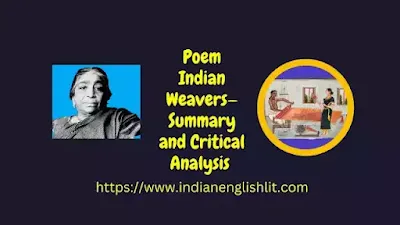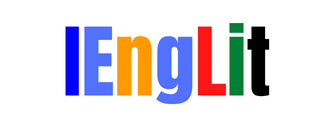Introduction of the Poem:
"Indian Weavers" is one of Sarojini Naidu's most popular poems and it is included in "The Golden Threshold". It is an exquisite poem and the symbolism of the Hindu trinity. The poetess, Sarojini Naidu skilfully uses the varied work of the Indian weavers as symbols of the pattern-grave and gay-woven by life. The harmony of three different times, day-break, night-fall and moonlight—with the work woven in each, makes the symbols peculiarly appropriate.
 |
| Poem Indian Weavers—Summary and Critical Analysis |
The poem introduces an Indian scene, that of weavers, weaving, particularly in the country-side, cloth on handlooms in different coloured patterns. The poem is in question-answer form. The poem is symbolic; rather allegorical, since it is only a thought, rather than an experience. The whole comedy and tragedy of human life is brought out here. The poem has a complex texture, which is woven into a harmonious whole by reference to birds, variegated colours, different hours of the day, different moods, similes and images and sound patterns.
Some Critical Points of the Poem :
1. The weavers are an integral part of Indian rural social fabric.
2. The weavers weave at all hours of day and night and represent the Trinity.
3. The poetess weaves three intricate patterns to convey the significant message about the human life.
4. The three encounters of the poetess with the weavers are significant because the times correspond to three stages in human life—the birth, the marriage and the death.
Stanza-Wise Summary :
Stanza 1 :
Weavers, weaving at break of day,
Why do you weave a garment so gay ? …..
Blue as the wing of a halcyon wild,
We weave the robes of a new-born child.
Explanatory Word-Meanings :
1. Weaver = one who weaves. 2. Weaving = interlacing threads in a loom. 3. Break of day = dawn. 4. Garment = dress. 5. Gay = bright coloured. 6. Halcyon = a fabulous bird of the old classical mythology. 7. Robes = dress. 8. New-born = newly born.
Summary of Stanza 1 :
Addressing the weavers, the poetess asks them why they are gladly weaving such a gay garment at dawn. At this the weavers reply that they are weaving cloth, which is blue like the wing of a wild halcyon, for the robes of a new-born child.
Stanza 2 :
Weavers, weaving at fall of night,
Why do you weave a garment so bright ? ….
Like the plumes of a peacock, purple and green,
We weave the marriage-veils of a queen.
Explanatory Word-Meanings :
1. Fall of night = the coming of night, dusk. 2. Plumes = feather. 3. Purple = red and blue mixed colours. 4. Marriage veil = piece of fine fabric worn as to conceal the face of bride.
Summary of the Stanza 2 :
The poetess addresses the weavers and asks them why they are happily weaving such a bright garment at fall of night. At this they reply that they weave cloth which is purple and green like the plumes of a peacock for the marriage veils of a queen.
Stanza 3 :
Weavers, weaving solemn and still,
What do you weave in the moonlight chill ? ….
White as a feather and white as a cloud,
We weave a dead man's funeral shroud.
Explanatory Word-Meanings :
1. Solemn and still = serious and silent, grave and quiet. 2. Chill = coldness. 3. Funeral shroud = cloth wrapped round a corpse.
Summary of the Stanza 3 :
Addressing the melancholy weavers, the poetess asks them what they are weaving so seriously and quietly in the cold moonlight. At this they reply that they are weaving a dead man's funeral shroud which is white like the feather of a bird and a patch of white cloud.
Critical Appreciation of the poem :
Introduction:
"Indian Weavers" is one of the most popular poems of Sarojini Naidu. It is included in "Golden Threshold". The whole poem is highly symbolic. Sarojini Naidu skilfully uses the varied work of the Indian weavers as symbols of the pattern—grave and gay—woven by life. The harmony of three different times, day-break, night-fall and moonlight—with the work woven in each, makes the symbols peculiarly appropriate. The poem introduces an Indian scene, that of weavers, weaving, particularly in the country-side, cloth on handlooms in different coloured patterns.
Form and Metre of the Poem:
The poem is in a question-answer form. The first two lines of each stanza contain the question and the last two lines, its answer. At break of day the gay weavers weave the robes of a new-born child. At fall of night they joyously weave a bright garment.
"Like the plumes of a peacock, purple and green,
We weave the marriage veils of a queen".
In the moonlight chill the solemn and still weavers weave a dead man's funeral shroud.
The poem contains three-quatrains, each of whose verse is a tetrameter. The first line of each stanza begins with two trochees and ends with three iambs. The arrangement in the fourth line is of two iambs, an anapest, and an iamb. The rhyme scheme is aa, bb. This is a unique pattern of prosodic rhythm, indeed. The poem is an artistic whole and is remarkable for its chaste and colourful diction and musical quality.
The Use of Symbols and Mythological Allusions:
The whole comedy and tragedy of human life is brought out here. The fates (here the weavers) are weaving the mingled web (texture) of human life. Belief in fate is almost a universal mythological phenomenon. In Greek mythology fates appear in the form of the three sisters, Clotho, Lachesis and Atropos, weaving the threads of birth, life and death of man. Fates in Indian mythology are embodied in the concept of Brahma, the God of creation, sitting on lotus coming out of the blue seas and recalling the blue of the halcyon wings in the the first stanza; Vishnu, the God of prosperity—marriage, wealth and splendour—recalling the splendour of the peacock plumes of the second stanza; and Rudra, the God of destruction—death besmirched in ash, corresponding with the white of the feather in the third stanza. All of them are depicted as engaged in their respective tasks of weaving the child's robes, the marriage-veil, and the funeral shroud symbolising birth (creation), prosperity (marriage) and death.
A Complete Texture Woven in Harmony:
The poem has a complete texture, which is woven into harmonious whole by reference to birds, variegated colours, different hours of the day, different moods, similes and images and sound patterns. The halcyon symbolises the spirit at the beginning of the creation and the sea stands for chaos which the halcyon churns into cosmos for the purposes of breeding. These two symbols that suggest birth and creation are, indeed, apt. The gay robes embodying the gaiety of Nature's heart at a newly-born life, the peacock with its green and purple plumes (feathers) and the nightfall (suggesting, the hour of expectancy), all go well with the queen's marriage veils, symbolising life's colour and splendour. The white feather (a feather torn off a dead bird) and the chilly moonlight and the weavers weaving in solemnity the funeral shroud, suggest destruction and death.






